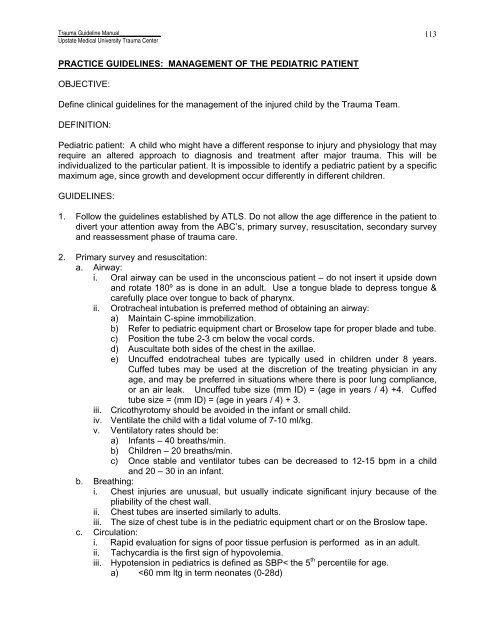Trauma Guideline Manual - SUNY Upstate Medical University
Trauma Guideline Manual - SUNY Upstate Medical University
Trauma Guideline Manual - SUNY Upstate Medical University
Create successful ePaper yourself
Turn your PDF publications into a flip-book with our unique Google optimized e-Paper software.
<strong>Trauma</strong> <strong>Guideline</strong> <strong>Manual</strong>______________<strong>Upstate</strong> <strong>Medical</strong> <strong>University</strong> <strong>Trauma</strong> Center113PRACTICE GUIDELINES: MANAGEMENT OF THE PEDIATRIC PATIENTOBJECTIVE:Define clinical guidelines for the management of the injured child by the <strong>Trauma</strong> Team.DEFINITION:Pediatric patient: A child who might have a different response to injury and physiology that mayrequire an altered approach to diagnosis and treatment after major trauma. This will beindividualized to the particular patient. It is impossible to identify a pediatric patient by a specificmaximum age, since growth and development occur differently in different children.GUIDELINES:1. Follow the guidelines established by ATLS. Do not allow the age difference in the patient todivert your attention away from the ABC’s, primary survey, resuscitation, secondary surveyand reassessment phase of trauma care.2. Primary survey and resuscitation:a. Airway:i. Oral airway can be used in the unconscious patient – do not insert it upside downand rotate 180º as is done in an adult. Use a tongue blade to depress tongue &carefully place over tongue to back of pharynx.ii.Orotracheal intubation is preferred method of obtaining an airway:a) Maintain C-spine immobilization.b) Refer to pediatric equipment chart or Broselow tape for proper blade and tube.c) Position the tube 2-3 cm below the vocal cords.d) Auscultate both sides of the chest in the axillae.e) Uncuffed endotracheal tubes are typically used in children under 8 years.Cuffed tubes may be used at the discretion of the treating physician in anyage, and may be preferred in situations where there is poor lung compliance,or an air leak. Uncuffed tube size (mm ID) = (age in years / 4) +4. Cuffedtube size = (mm ID) = (age in years / 4) + 3.iii. Cricothyrotomy should be avoided in the infant or small child.iv. Ventilate the child with a tidal volume of 7-10 ml/kg.v. Ventilatory rates should be:a) Infants – 40 breaths/min.b) Children – 20 breaths/min.c) Once stable and ventilator tubes can be decreased to 12-15 bpm in a childand 20 – 30 in an infant.b. Breathing:i. Chest injuries are unusual, but usually indicate significant injury because of thepliability of the chest wall.ii. Chest tubes are inserted similarly to adults.iii. The size of chest tube is in the pediatric equipment chart or on the Broslow tape.c. Circulation:i. Rapid evaluation for signs of poor tissue perfusion is performed as in an adult.ii. Tachycardia is the first sign of hypovolemia.iii. Hypotension in pediatrics is defined as SBP< the 5 th percentile for age.a)
















